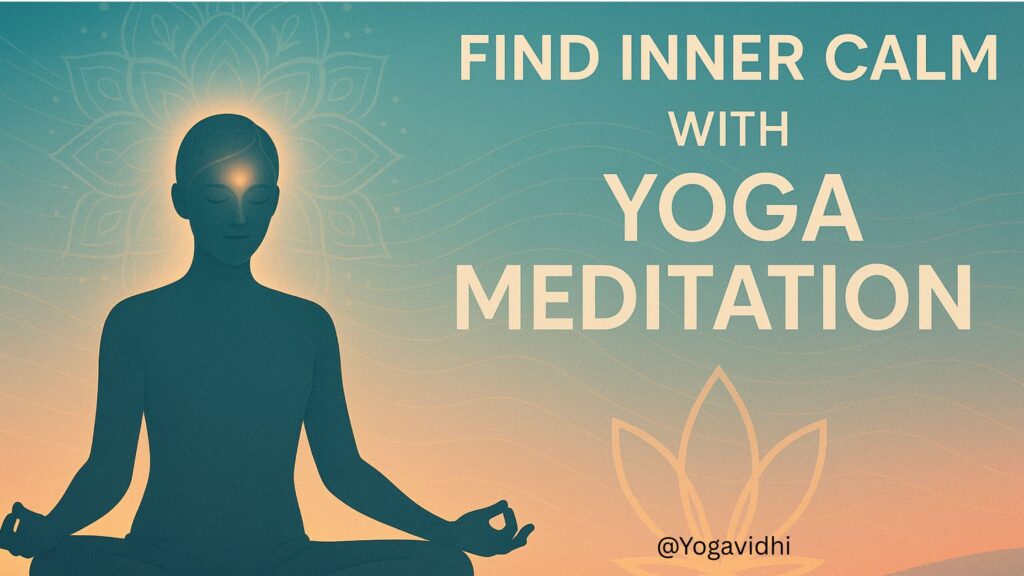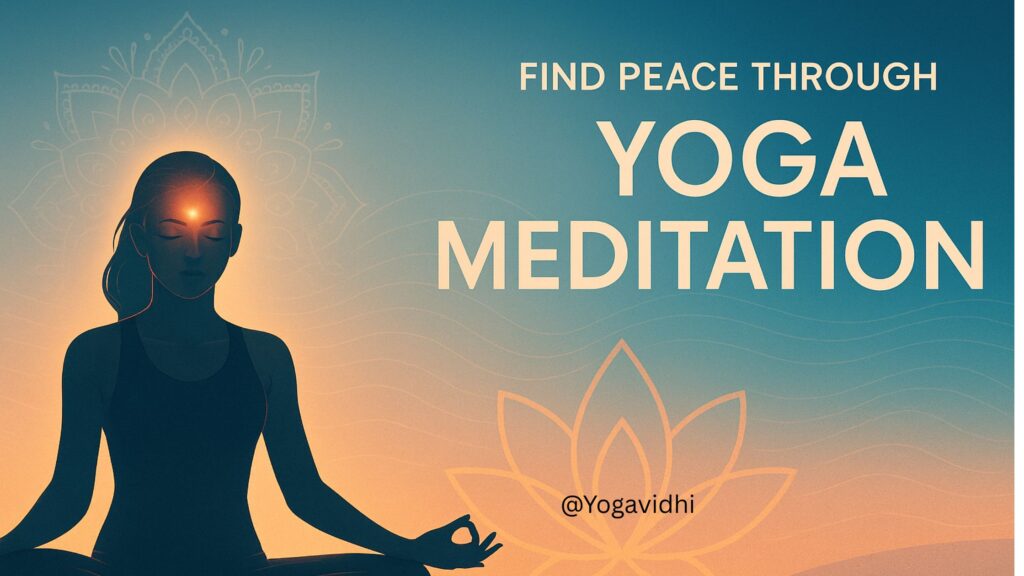In today’s high-speed world, finding peace of mind feels more elusive than ever. Our screens never sleep, our minds rarely rest, and stress has become the new norm. If you’re searching for a natural, sustainable way to calm your mind and heal your body, look no further than yoga meditation.
Combining the ancient wisdom of yoga with the mindfulness of meditation, this powerful practice offers a holistic way to de-stress, recharge, and reconnect with your inner self. Whether you’re a beginner or a seasoned yogi, integrating yoga meditation into your daily life can transform your mental, physical, and emotional health.
In this guide, we’ll explore what yoga meditation really is, why it’s so effective, and how you can start your journey toward a more balanced, peaceful life.
Yoga meditation involves uniting physical postures (asanas) with focused mental attention to cultivate deep relaxation and heightened awareness. It often includes breath control and mindfulness practices. As a fundamental part of yoga philosophy, its goal is to quiet the mind, improve concentration, and support overall well-being.
Table of Contents
What Is Yoga Meditation?
Yoga meditation is the harmonious blend of two ancient practices: yoga, which involves physical postures (asanas), breath control (pranayama), and ethical living, and meditation, the practice of focused awareness and mindfulness.
Together, yoga and meditation create a powerful synergy. Yoga prepares the body for stillness, helping to release physical tension, while meditation trains the mind to be calm and focused. The result? A state of inner peace, deep awareness, and emotional resilience.
The Benefits of Yoga Meditation
Let’s face it — life is stressful. But yoga meditation offers a proven solution to counteract that stress and more. Here’s how:
Mental & Emotional Benefits
- Reduces anxiety and depression
- Promotes emotional stability and resilience
- Increases mental clarity and focus
- Encourages mindfulness and presence
Physical Benefits
- Improves posture and flexibility
- Lowers blood pressure and heart rate
- Enhances sleep quality
- Boosts immune function
Spiritual Benefits
- Deepens self-awareness
- Cultivates inner peace and compassion
- Connects you to a higher purpose or consciousness
In essence, yoga meditation doesn’t just change how you feel—it changes how you live.
Types of Yoga Meditation
Not all meditation in yoga looks the same. Here are some popular types of yoga meditation to explore:
1. Mindfulness Meditation
Focus on the breath, bodily sensations, or the present moment. It’s perfect for beginners and effective for reducing stress and anxiety.
2. Chakra Meditation
Focus on your body’s seven chakras to unblock energy and restore balance. Often paired with specific breathing techniques and visualizations.
3. Mantra Meditation
Involves the repetition of a sacred word or phrase, such as “Om,” to help maintain focus and elevate consciousness.
4. Yoga Nidra (Yogic Sleep)
A guided, deeply relaxing form of meditation practiced in a lying-down position. Ideal for those with insomnia or stress -related issues.
5. Kundalini Meditation
A more intense practice combining postures, mantras, and breathwork to awaken energy at the base of the spine.
Each of these styles helps you access a different layer of awareness, energy, and transformation.
How to Practice Yoga Meditation: A Step-by-Step Guide
Starting a yoga meditation practice doesn’t require fancy gear or years of experience. Here’s how to get started, one mindful breath at a time:
Step 1: Set the Scene
Choose a quiet space. Use a mat, cushion, or folded blanket to sit comfortably.
Step 2: Prepare Your Body
Do 5–10 minutes of gentle yoga stretches (like Cat-Cow or Child’s Pose) to loosen tension.
Step 3: Focus on Breath
Begin with deep belly breathing or alternate nostril breathing to calm the mind.
Step 4: Choose Your Method
Decide if you’ll focus on your breath, a mantra, or a visual (like a candle flame or chakra).
Step 5: Sit in Stillness
Maintain a posture like Sukhasana (Easy Pose) or Padmasana (Lotus Pose). Sit upright with your spine straight and shoulders relaxed.
Step 6: Stay Consistent
Start with 5–10 minutes daily. Gradually increase as your focus improves.
Consistency, not complexity, is the secret to reaping the benefits.
Read More: Evening Yoga: Unwind, Relax, and Sleep Better Naturally
Read More: Morning Yoga: Start Your Day with Energy, Clarity, and Calm
Yoga Poses to Support Meditation
Before sitting for meditation, your body may need to release tension. Try these yoga poses to prepare both body and mind:
- Sukhasana (Easy Pose) – Calms the mind, promotes groundedness
- Padmasana (Lotus Pose) – Deepens meditation, keeps the spine aligned
- Viparita Karani (Legs-Up-the-Wall) – Reduces fatigue and anxiety
- Balasana (Child’s Pose) – Relieves tension in the back and neck
- Savasana (Corpse Pose) – Promotes total relaxation
These poses gently prime your nervous system for stillness and introspection.
| Category | Details |
| Definition | The combination of yoga postures, breathing techniques, and meditation practices to promote holistic well-being. |
| Main Benefits | – Reduces stress and anxiety – Improves focus and sleep – Enhances flexibility and emotional balance |
| Popular Types | – Mindfulness Meditation – Chakra Meditation – Mantra Meditation – Yoga Nidra – Kundalini Meditation |
| Preparation Steps | 1. Set a quiet space 2. Stretch or do light yoga 3. Practice breathwork 4. Sit in stillness 5. Be consistent |
| Ideal Yoga Poses | Sukhasana, Padmasana, Balasana, Viparita Karani, Savasana |
| Recommended Tools | Yoga mat, cushion, mala beads, essential oils, guided meditation apps |
| Challenges & Solutions | – Wandering mind → Use breath/mantra as anchor – Discomfort → Use props – No time → Start with 5 minutes |
| Best Times to Practice | – Early morning for energy and clarity – Evening for stress relief and better sleep |
| Specific Uses | Sleep improvement, anxiety reduction, focus building, emotional healing |
| Scientific Backing | Lowers cortisol, improves brain function, supports mental health, enhances neuroplasticity |
Tools to Enhance Your Practice
While yoga meditation requires very little, some tools can elevate your experience:
- Yoga Mat & Cushion: Provides comfort and alignment
- Essential Oils: Lavender or sandalwood can aid relaxation
- Mala Beads: Help count mantras and anchor attention
- Sound Therapy: Use singing bowls or nature sounds for focus
Using the right tools can create a sacred space that encourages consistency and calm.
Common Challenges & How to Overcome Them
Like any habit, yoga meditation has its hurdles—but don’t let them stop you:
“My mind keeps wandering.”
That’s normal. Gently bring your focus back to the breath or mantra each time.
“I feel uncomfortable sitting.”
Use props or try reclining yoga nidra until your body adjusts.
“I don’t have time.”
Start with just 5 minutes a day. Even small sessions are powerful.
The key is patience. Meditation is a journey, not a destination.
Yoga Meditation for Specific Goals
Target your practice to meet your personal wellness needs:
- Yoga Meditation for Sleep: Practice before bedtime with yoga nidra or breathwork
- Yoga Meditation for Anxiety: Use grounding techniques and mindfulness
- Yoga Meditation for Focus: Try mantra repetition or chakra visualizations
- Yoga Meditation for Healing: Embrace guided visualizations and gentle asanas
With the right intention, yoga meditation can be tailored to serve your goals and lifestyle.
Science Behind Yoga Meditation
Studies confirm what yogis have known for centuries:
- Yoga meditation reduces cortisol (stress hormone)
- Improves brain plasticity and memory
- Enhances emotional regulation and sleep
- Decreases symptoms of depression and anxiety
Leading institutions like Harvard, UCLA, and Johns Hopkins have conducted clinical research supporting the physical and mental benefits of yoga meditation.
Integrate Yoga Meditation into Your Daily Life
You don’t need a mountaintop or a retreat to experience the magic of yoga meditation. Try these simple ways to make it part of your daily routine:
- Morning: Start the day with 10 minutes of seated breathwork
- Midday: Use a 5-minute walking meditation during your lunch break
- Evening: Unwind with yoga nidra or a gentle body scan before sleep
- Digital Detox: Use meditation to replace doomscrolling with presence
Little by little, yoga meditation becomes less of a “practice” and more of a way of life.

Final Thoughts: Start Your Yoga Meditation Journey Today
Yoga meditation is more than a trend—it’s a timeless practice that empowers you to live with purpose, presence, and peace. It doesn’t matter if you’re stiff, distracted, or busy. All you need is your breath and the willingness to begin.
So why not take the first step today? Sit down. Close your eyes. Breathe in deeply. Exhale slowly. In that moment, you’re practicing yoga meditation—and that’s where transformation begins.
Frequently Asked Question (FAQ):
Q. Can I combine yoga and meditation in one session?
Ans: Absolutely. Practicing yoga postures followed by a short meditation enhances physical relaxation and mental focus, making your meditation more effective.
Q. How long should I meditate during yoga practice?
Ans: If you’re just starting out, even 5–10 minutes of yoga meditation can make a big difference. As you become more comfortable, aim for 15–30 minutes to experience deeper mental clarity and relaxation.
Q. Do I need to be flexible to do yoga meditation?
Ans: Not at all! Yoga meditation is more about inner awareness than physical flexibility. You can sit on a chair, use cushions, or even lie down in Savasana. Comfort is key for effective meditation.
Q. What’s the best time of day to practice yoga meditation?
Ans: Early morning (Brahma Muhurta) is ideal, as your mind is fresh and distractions are minimal. However, evenings also work well to unwind from the day. The best time is when you can be consistent.
Q. Can yoga meditation help with anxiety and stress?
Ans: Yes, absolutely. Yoga meditation helps calm the nervous system, lowers cortisol levels, and promotes mindfulness. Practices like breath awareness, mantra repetition, and Yoga Nidra are especially helpful for managing anxiety and stress.
Q. What is the meaning of yoga meditation?
Ans: Yoga meditation blends physical postures (asanas), breath control (pranayama), and focused attention (meditation) to promote mental clarity, deep relaxation, and a sense of unity with oneself or a higher consciousness. This practice helps calm the mind, ease stress, and develop awareness of the present moment.
Q. How is yoga meditation done?
Ans: Settle into your meditative posture and ensure you’re comfortable. Gently close your eyes and bring your awareness to the sensation of the breath at your nostrils. Observe this sensation steadily for several minutes, noticing the coolness of each inhalation and the warmth of each exhalation.
Q. Which type of yoga is meditation?
Ans: Yoga Nidra is a guided meditation technique that promotes deep relaxation and heightened awareness. Often referred to as “yogic sleep,” it is typically practiced while lying down in a comfortable position.
Declaration Note:
We use third-party videos and images on https://yogavidhi.com/ for educational and illustrative purposes. All rights belong to their respective owners. No copyright infringement is intended.



